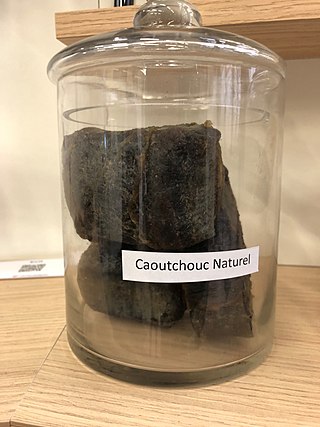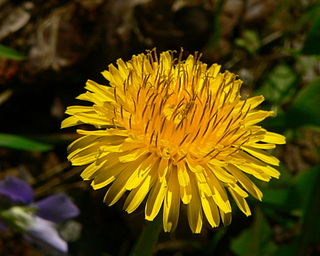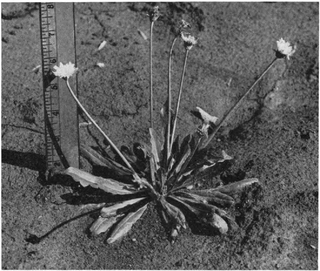
Rubber, also called India rubber, latex, Amazonian rubber, caucho, or caoutchouc, as initially produced, consists of polymers of the organic compound isoprene, with minor impurities of other organic compounds. Thailand, Malaysia, Indonesia, and Cambodia are four of the leading rubber producers.

Tragopogon, also known as goatsbeard or salsify, is a genus of flowering plants in the family Asteraceae. It includes the vegetable known as salsify, as well as a number of common wild flowers.

Hevea brasiliensis, the Pará rubber tree, sharinga tree, seringueira, or most commonly, rubber tree or rubber plant, is a flowering plant belonging to the spurge family Euphorbiaceae originally native to the Amazon basin, but is now pantropical in distribution due to introductions. It is the most economically important member of the genus Hevea because the milky latex extracted from the tree is the primary source of natural rubber.

Parthenium argentatum, commonly known as the guayule, is a perennial woody shrub in the family Asteraceae that is native to the rangeland area of the Chihuahuan Desert; including the southwestern United States and northern Mexico. It was first documented by J.M. Bigelow in 1852 through the Mexican Boundary Survey and was first described by Asa Gray. Natural rubber, ethanol, non-toxic adhesives, and other specialty chemicals can be extracted from guayule. An alternative source of latex that is hypoallergenic, unlike the normal Hevea rubber, can also be extracted. While Castilla elastica was the most widely used rubber source of Mesoamericans in pre-Columbian times, guayule was also used, though less frequently. The name "guayule" derives from the Nahuatl word ulli/olli, "rubber".

Scorzonera is a genus of flowering plants in the tribe Cichorieae within the family Asteraceae.

Eucommia ulmoides is a species of small tree native to China. It belongs to the monotypic family Eucommiaceae. It is considered vulnerable in the wild, but is widely cultivated in China for its bark and is highly valued in herbology such as traditional Chinese medicine.

Ficus elastica, the rubber fig, rubber bush, rubber tree, rubber plant, or Indian rubber bush, Indian rubber tree, is a species of flowering plant in the family Moraceae, native to eastern parts of South and Southeast Asia. It has become naturalized in Sri Lanka, the West Indies, and the US state of Florida. Despite its common names, it is not used in the commercial production of natural rubber.

The nutmeg, also known as the clover cutworm, is a moth of the family Noctuidae.

Rubber tapping is the process by which latex is collected from a rubber tree. The latex is harvested by slicing a groove into the bark of the tree at a depth of one-quarter inch (6.4 mm) with a hooked knife and peeling back the bark. Trees must be approximately six years old and six inches (150 mm) in diameter in order to be tapped for latex.

Castilla elastica, the Panama rubber tree, is a tree native to the tropical areas of Mexico, Central America, and northern South America. It was the principal source of latex among the Mesoamerican peoples in pre-Columbian times. The latex gathered from Castilla elastica was converted into usable rubber by mixing the latex with the juice of the morning glory species Ipomoea alba which, conveniently, is typically found in the wild as a vine climbing Castilla elastica. The rubber produced by this method found several uses, including most notably, the manufacture of balls for the Mesoamerican ballgame ōllamaliztli.

Taraxacum officinale, the dandelion or commondandelion, is a herbaceous perennial flowering plant in the daisy family Asteraceae. The common dandelion is well known for its yellow flower heads that turn into round balls of many silver-tufted fruits that disperse in the wind. These balls are called "clocks" in both British and American English. The name "blowball" is also used.
Rubberwood is a light-colored medium-density tropical hardwood obtained from the Pará rubber tree, usually from trees grown in rubber plantations. Rubberwood is commonly advertised as an "environmentally friendly" wood, as it makes use of plantation trees that have already served a useful function.

The Cichorieae are a tribe in the plant family Asteraceae that includes 93 genera, more than 1,600 sexually reproductive species and more than 7,000 apomictic species. They are found primarily in temperate regions of the Eastern Hemisphere. Cichorieae all have milky latex and flowerheads that only contain one type of floret. The genera Gundelia and Warionia only have disk florets, while all other genera only have ligulate florets. The genera that contain most species are Taraxacum with about 1,600 apomictic species, Hieracium with about 770 sexually reproducing and 5,200 apomictic species, and Pilosella with 110 sexually reproducing and 700 apomictic species. Well-known members include lettuce, chicory, dandelion, and salsify.

Euphorbiaceae, the spurge family, is a large family of flowering plants. In English, they are also commonly called euphorbias, which is also the name of the type genus of the family. Most spurges, such as Euphorbia paralias, are herbs, but some, especially in the tropics, are shrubs or trees, such as Hevea brasiliensis. Some, such as Euphorbia canariensis, are succulent and resemble cacti because of convergent evolution. This family has a cosmopolitan global distribution. The greatest diversity of species is in the tropics; however, the Euphorbiaceae also have many species in nontropical areas of all continents except Antarctica.

Latex is an emulsion of polymer microparticles in water. Latexes are found in nature, but synthetic latexes are common as well.

Taraxacum is a large genus of flowering plants in the family Asteraceae, which consists of species commonly known as dandelions. The scientific and hobby study of the genus is known as taraxacology. The genus is native to Eurasia and North America, but the two most commonplace species worldwide, T. officinale and T. erythrospermum, were introduced from Europe into North America, where they now propagate as wildflowers. Both species are edible in their entirety. The common name dandelion is also given to specific members of the genus.

Neglected and underutilized crops are domesticated plant species used for food, medicine, trading or cultural practices that are significant within their local communities but are not widely commodified or studied as part of mainstream agriculture. Such crops may be in declining production. They are considered underutilized in scientific inquiry for their perceived potential to contribute to knowledge regarding nutrition, food security, genetic resistance, or sustainability. Other terms to describe such crops include minor, orphan, underused, local, traditional, alternative, minor, niche, or underdeveloped.

Taraxacum kok-saghyz, often abbreviated as TKS and commonly referred to as the Kazakh dandelion, rubber root, or Russian dandelion, is a species of dandelion native to Kazakhstan, Kyrgyzstan and Uzbekistan, notable for its production of high-quality rubber. T. kok-saghyz was discovered in Kazakhstan in 1932 by Soviet scientists seeking a domestic source of rubber.

Takhtajaniantha is a genus of flowering plants in the tribe Cichorieae within the family Asteraceae.

Taraxacum hybernum, also known as Krim-Saghyz, or Autumn dandelion, is a perennial species of flowering plant in the family Asteraceae. In dry spring it produces only a rosette of leaves. In the wild, it blooms in spring or autumn, depending on moisture conditions, as a cultivated plant it has been reported to have 2 flowerings in one season.



















